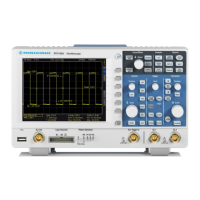

Do you have a question about the R&S RTC1000 and is the answer not in the manual?
| Type | Digital Oscilloscope |
|---|---|
| Vertical Resolution | 8 Bit |
| Display Type | TFT LCD |
| Bandwidth | 100 MHz |
| Channels | 2 |
| Memory Depth | 10 Mpts |
| Weight | 2.5 kg |
| Interfaces | USB, LAN |
| Input Impedance | 1 MΩ |
| Max Input Voltage | 400 V (DC + AC peak) |
Details essential safety precautions and warnings for operating the R&S RTC1000 oscilloscope.
Guides on unpacking, checking, and positioning the R&S RTC1000 oscilloscope for initial setup.
Covers settings for channel selection, vertical scale, position, coupling, and bandwidth.
Explains how to adjust timebase, trigger position, and acquisition settings for waveform analysis.
Details acquisition modes, settings, and record modes like RUN/STOP, SINGLE, and AUTO.
Guides on configuring trigger mode, source, type, and hold-off time for signal capture.
Explains AUTO/NORM, SINGLE trigger modes, TYPE, HOLD OFF, and SOURCE settings.
Covers Quick Mathematics (QM) and Advanced Mathematics (MA) for waveform calculations.
Details how to use cursors for precise measurements of voltage, time, ratio, and counts.
Explains how to configure and use automatic measurements for up to six parameters simultaneously.
Guides on defining buses (B1, B2) and selecting bus types like Parallel, SPI, I2C, UART, CAN, LIN.